Life with Father is a 1939 play by Howard Lindsay and Russel Crouse, adapted from a humorous autobiographical book of stories compiled in 1935 by Clarence Day. The Broadway production ran for 3,224 performances over 401 weeks to become the longest-running non-musical play on Broadway, a record that it still holds. The play was adapted into a 1947 feature film and a television series.
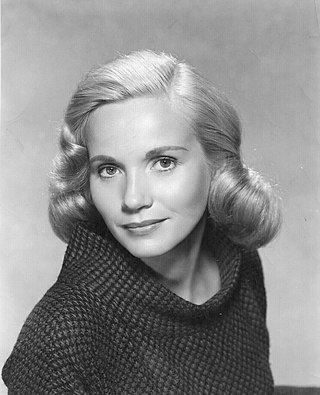
Eva Marie Saint is an American retired actress of film, theatre, radio and television. In a career that spanned nearly 80 years, she won an Academy Award and a Primetime Emmy Award, alongside nominations for a Golden Globe Award and two British Academy Film Awards. Saint is the oldest living and earliest surviving Academy Award-winner, and one of the last living stars from the Golden Age of Hollywood.
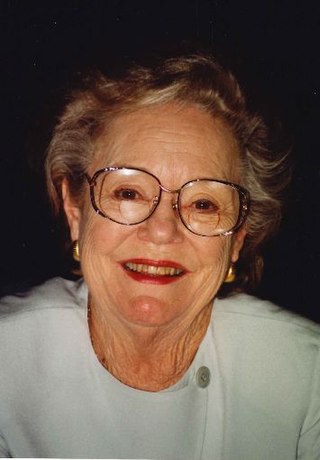
Patricia Alma Hitchcock O'Connell was an English-American actress and producer. She was the only child of English director Alfred Hitchcock and film editor Alma Reville, and had small roles in several of her father's films, with her most substantial appearance being in Strangers on a Train (1951).

Carolyn Sue Jones was an American actress of television and film. She began her film career in the early 1950s, and by the end of the decade had achieved recognition with a nomination for an Academy Award for Best Supporting Actress for The Bachelor Party (1957) and a Golden Globe Award as one of the most promising new actresses of 1959. Her film career continued for another 20 years. In 1964, Jones began playing the role of matriarch Morticia Addams in the black and white television series The Addams Family.
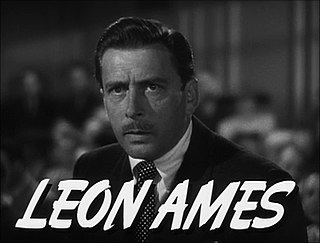
Leon Ames was an American film and television actor. He is best remembered for playing father figures in such films as Meet Me in St. Louis (1944), Little Women (1949), On Moonlight Bay (1951) and By the Light of the Silvery Moon (1953). His best-known dramatic role may have been in the crime film The Postman Always Rings Twice (1946).
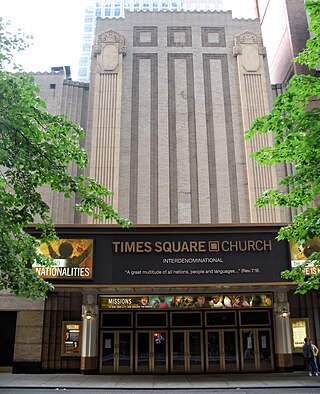
The Mark Hellinger Theatre is a church building at 237 West 51st Street in the Midtown Manhattan neighborhood of New York City, which formerly operated as a cinema and Broadway theater. Opened in 1930, the Hellinger Theatre is named after journalist Mark Hellinger and was developed by Warner Bros. as a movie palace. It was designed by Thomas W. Lamb with a modern facade and a Baroque interior. It has 1,605 seats across two levels and has been a house of worship for the Times Square Church since 1989. Both the exterior and interior of the theater are New York City landmarks.

The Neil Simon Theatre, originally the Alvin Theatre, is a Broadway theater at 250 West 52nd Street in the Theater District of Midtown Manhattan in New York City. Opened in 1927, the theater was designed by Herbert J. Krapp and was built for Alex A. Aarons and Vinton Freedley. The original name was an amalgamation of Aarons's and Freedley's first names; the theater was renamed for playwright Neil Simon in 1983. The Neil Simon has 1,467 seats across two levels and is operated by the Nederlander Organization. Both the facade and the auditorium interior are New York City landmarks.

The Ed Sullivan Theater is a theater at 1697–1699 Broadway, between 53rd and 54th Streets, in the Theater District of Midtown Manhattan in New York City. Built from 1926 to 1927 as a Broadway theater, the Sullivan was developed by Arthur Hammerstein in memory of his father, Oscar Hammerstein I. The two-level theater was designed by Herbert J. Krapp with over 1,500 seats, though the modern Ed Sullivan Theater was downsized to 370 seats by 2015. The neo-Gothic interior is a New York City landmark, and the building is on the National Register of Historic Places.

The Hayes Theater is a Broadway theater at 240 West 44th Street in the Theater District of Midtown Manhattan in New York City. Named for actress Helen Hayes, the venue is operated by Second Stage Theater. It is the smallest Broadway theater, with 597 seats across two levels. The theater was constructed in 1912 for impresario Winthrop Ames and designed by Ingalls & Hoffman in a neo-Georgian style. The original single-level, 299-seat configuration was modified in 1920, when Herbert J. Krapp added a balcony to expand the Little Theatre. The theater has served as a legitimate playhouse, a conference hall, and a broadcasting studio throughout its history.

Paul Hartman was an American dancer, stage performer and television actor.

Father of the Bride is an American sitcom that aired on CBS during the 1961–62 season. The television series centers around the challenges an unready father faces as he adjusts to his daughter's engagement and marriage. Cast members include Leon Ames as the father of the bride, Ruth Warrick as the mother, and Myrna Fahey as the bride.

The Longacre Theatre is a Broadway theater at 220 West 48th Street in the Theater District of Midtown Manhattan in New York City, United States. Opened in 1913, it was designed by Henry B. Herts and was named for Longacre Square, now known as Times Square. The Longacre has 1,077 seats and is operated by The Shubert Organization. Both the facade and the auditorium's interior are New York City designated landmarks.

The Booth Theatre is a Broadway theater at 222 West 45th Street in the Theater District of Midtown Manhattan in New York City. Opened in 1913, the theater was designed by Henry Beaumont Herts in the Italian Renaissance style and was built for the Shubert brothers. The venue was originally operated by Winthrop Ames, who named it for 19th-century American actor Edwin Booth. It has 800 seats across two levels and is operated by The Shubert Organization. The facade and parts of the interior are New York City landmarks.
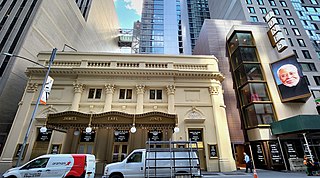
The James Earl Jones Theatre, originally the Cort Theatre, is a Broadway theater at 138 West 48th Street, between Seventh Avenue and Sixth Avenue, in the Theater District of Midtown Manhattan in New York City, United States. It was built in 1912 and designed by architect Thomas W. Lamb for impresario John Cort. An annex to the west of the theater, built between 2021 and 2022, was designed by Kostow Greenwood Architects. The Jones has 1,092 seats across three levels and is operated by the Shubert Organization. Both the facade and interior of the theater are New York City designated landmarks.

The Stephen Sondheim Theatre, formerly Henry Miller's Theatre, is a Broadway theater at 124 West 43rd Street in the Theater District of Midtown Manhattan in New York City. Owned by the Durst Organization and managed by the Roundabout Theatre Company, the modern 1,055-seat theater opened in 2009 at the base of the Bank of America Tower. The current theater is mostly underground and was designed by Cookfox, architects of the Bank of America Tower. It retains the landmarked facade of the original Henry Miller's Theatre, which was built in 1918 by Henry Miller, the actor and producer.

Lurene Tuttle was an American actress and acting coach, who made the transition from vaudeville to radio, and later to films and television. Her most enduring impact was as one of network radio's more versatile actresses. Often appearing in 15 shows per week, comedies, dramas, thrillers, soap operas, and crime dramas, she became known as the "First Lady of Radio".

Saints and Sinners is an American drama series that aired on NBC during the 1962-63 television season. The program starred Nick Adams as newspaper reporter Nick Alexander. Saints and Sinners was created by Adrian Spies, who worked as a journalist before becoming a screenwriter.
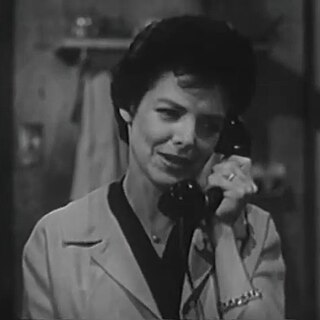
Lori March was an American television actress. She was best known for her roles on daytime soap operas. Her obituary on the Television Academy's web site noted that she "was dubbed 'First Lady of Daytime Television'."

Village East by Angelika is a movie theater at 189 Second Avenue, on the corner with 12th Street, in the East Village of Manhattan in New York City. Part of the former Yiddish Theatre District, the theater was designed in the Moorish Revival style by Harrison Wiseman and built from 1925 to 1926 by Louis Jaffe. In addition to Yiddish theatre, the theater has hosted off-Broadway shows, burlesque, and movies. Since 1991, it has been operated by Angelika Film Center as a seven-screen multiplex. Both the exterior and interior of the theater are New York City designated landmarks, and the theater is on the National Register of Historic Places.

"Helen Morgan" is an American television play broadcast on May 16, 1957, as part of the CBS television series, Playhouse 90. It was the 33rd episode of the first season of Playhouse 90.



















